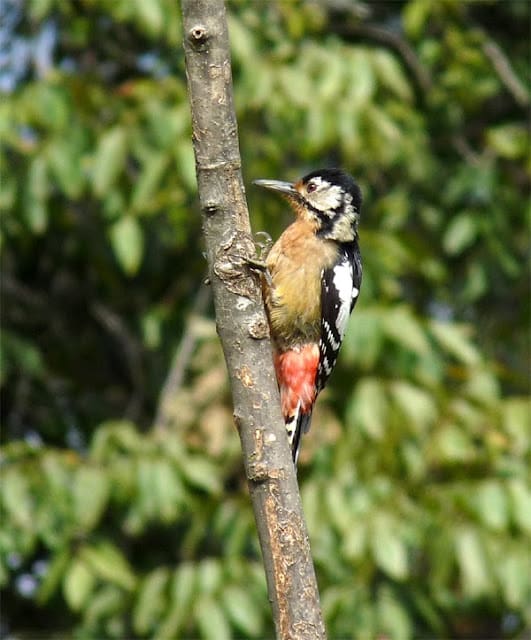I was drawn to the massif gleaming in the horizon as it towered over the lesser ranges in the foreground
 |
| Chaukhamba (right) from Bedni Bugyal. The peak next to it is Shivling (near Gangotri). Photo: Sahastrarashmi (2002) |
In September 2009, Sahastra and I took a train from Delhi to Haridwar and ventured on our second trip together to the Himalayas. On the first leg we aimed to explore the trail to Tungnath, one of the five sacred shrines dedicated to Shiva (known as the Panch Kedar). We began by taking the trail to Deoria Tal from Ukhimath, a hillside town overlooking the Mandakini. As we discovered the next morning, the mountain river, one of the tributaries of the Ganga, was a glinting turquoise ribbon thousands of feet in the valley below. Yet its muffled roar sought us out like a persistent stage whisper.
We had spent an exhausting day riding a cramped made-for-the-mountains bus from Haridwar to Ukhimath via Rudraprayag, the confluence of the Mandakini and the Alaknanda rivers. At 4 pm the town, made respectively famous and notorious by by Jim Corbett and a man-eating leopard in the 1920s, was hot, muggy and swarming with flies. It didn’t feel like we were in the Himalayas at all.
At Ukhimath we found some respite though it wasn’t cold as we had expected (or hoped — because the Himalayan cold is at once welcome and frightening). The peak of Kedarnath, lit by the embers of a long-gone sun, presided over a great part of the evening as we sat on the lawns of the GMVN guesthouse running over our plans for the next day.
 |
| Chaukhamba from Deoria Tal |
A jeep driver dropped us off at Sari, the roadhead to Deoria Tal. Glad to be on foot again after many months, we began a laboured ascent to the lake as our city-slicker lungs acclimated to the altitude. Oak and rhododendron paved the fern-fringed path. Warblers abounded in the low canopy. As the sun came out, griffons began to circle overhead. On the sun-warmed rocks, Kashmir Rock Agamas sat motionless, their slaty blue limbs blending into the smooth stone beneath them. Some of them appeared to be making a meal of small flowers growing among the grass.
 |
| Kashmir Agamas basking in the sun |
After climbing 4 km and about 3000 vertical feet, we arrived at a glade. Sahastra, who was walking ahead of me, exclaimed, “You must see this!” A gentle meadow began where the forest ended. The edges of a limpid lake reflected the charcoal sky. And ahead of it, presiding over the horizon, was a massif. It had to be Chaukhamba.
Chaukhamba — the name literally means four pillars — is one of the highest peaks in the Garhwal region of Uttarakhand. The spires range in elevation from 23,419 feet (Chaukhamba 1) to 22,487 feet (Chaukhamba 4). The highest peak was first summited in 1952 by Lucien George and Victor Russenberger, two Swiss members of a French expedition (source: Wikipedia).
 |
| A Himalayan Woodpecker tries its luck on a slender tree |
We admired the peak in awe for a long time and then explored the lake. A variety of warblers and flycatchers were in abundance. White wagtails chased insects in the grass while a Himalayan woodpecker knocked on wood for luck. Black-headed jays were almost tame, coming up to the kitchen shack for morsels.
Chaukhamba remained a persistent presence on our journey from Chopta to Tungnath and all the way up to Chandrashila, at 13,123 feet the highest peak on this trail.
 |
| Chaukhamba from the trail to Tungnath |
Two years earlier, on a trek to Bedni Bugyal via Loharjung pass, I had encountered Chaukhamba for the first time. Climbing through an oak forest from the hamlet of Didana toward Ali Bugyal, I was drawn to a mountain gleaming in the horizon as it towered over the lesser ranges that had eclipsed it while we were at lower altitudes. I distinctly remembered its massive hulking form and the four spires. As we watched, clouds veiled the view and we did not see it again.
Chaukhamba has since dominated my memory of the Himalayas. Up until I glimpsed the serene and stately form of Nanda Devi from Auli. But that is another story.
Text and photos by Beej
Main photo by Sahastrarashmi
- TL;DR – Death Stalks Like A Marabou Stork - July 24, 2024
- Dimorphic Egret – Meet this East African mystery bird - June 8, 2024
- Encounter: Northern Treeshrew in Arunachal Pradesh - May 19, 2024

Wonderful account of your travel! Please do let me know when you are going next. I would also like to accompany you. – Sanjay.